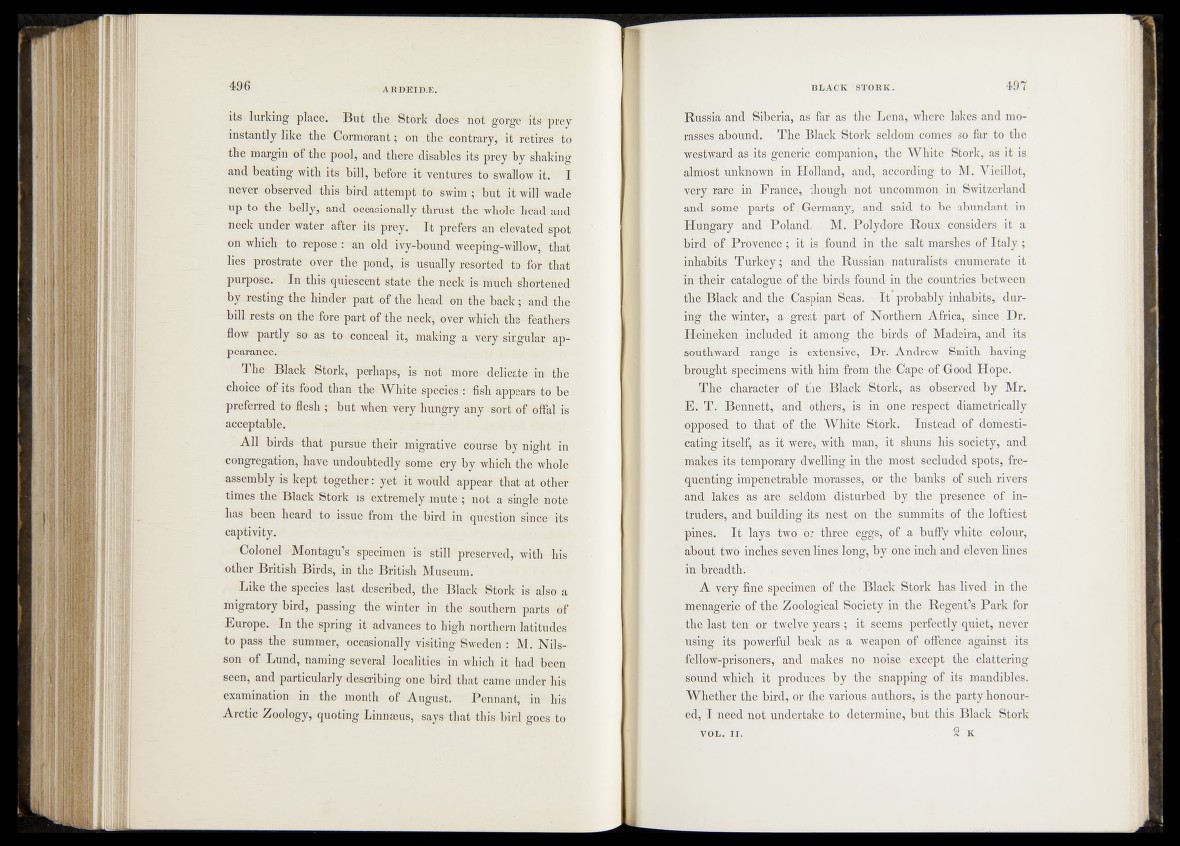
its lurking place. But the- Stork does not gorge its prey
instantly like the Cormorant; on .the contrary, it retires to
the margin of the pool, and there disables its prey by shaking
and beating with its bill, before it ventures tip swallow it.' I
never observed this bird attempt to swim ; but. it will wade
up to the belly, and ' occasionally thrust the whole head and
neck under water after its prey. I t prefers an elevated spot
on which to repose : an old ivy-bound weeping-willow, that
lies prostrate over the pond, is* usually resorted to- för that
purpose. In this quiescent state the neck is much shortened
by resting the'hinder part of the head on the backhand the
bill rests on the fore part of the neck, over, which the -feathers
flow partly so as to conceal it, making a very singular appearance.
The Black Stork, perhaps^ is not more delicate in tlfe
choice o f its food than the Wbite species : fish appears tct be
preferred to flesh ; but when very hungry any sort of offal is
acceptable.
All birds that pursue their migrative course by night in
congregation, have undoubtedly some cry by which the- whole
assembly is kept together : yet it wohld appear that at other
times the Black Stork is extremely mute ; not a single note
has been heard to issue from the bird in question since1*'its
captivity.
Colonel Montagu’s specimen is still preserved,' with his
other British Birds, in the British Museum.
- Like the species last described, the Black Stork is also a
migratory bird, passing the winter in the southern parts
Europe. In the spring it advances to high northern latitudes
to pass the summer, occasionally visiting Sweden : M. Nilsson
of Lund, naming several localities in which it had been
séen, and particularly describing one bird that came under his
examination in the month of August* Pennant, in his
Arctic Zoology, quoting Linnæus, says that this bird goes to
Russia and Siberia, as far as the Lena, where lakes and morasses
abound. The Black Stork seldom comes so far to the
westward as its generic. companion, the White Stork, as it is
almost unknown in Holland, and, according to M. Vieillot,
very rare in France,, though not uncommon in Switzerland
and some parts o f. Germany, and said to be abundant in
Hungary and - Poland.' M. Polydore Roux considers it a
bird of Proven,ce;> it i$£found in th e . salt marshes of Italy ;
inhabits Turkey; anditjie Russian- naturalists enumerate it
in their catalogue- of the birds found in the countries between
the Black and the Caspian .Seas. - I t probably inhabits, during
the winter, a. great part of Northern Africa,. since Dr.
Heinejkpn included jit* among ^the .birds , of Madeira, and its
southward range is extensive, Dr. Andrew; Smith having
brought specimens with him from ^the -Cape of Good Hope.
The character of the -Black Stork; as observed by Mr.
E. T. Bennett, and 'others,, is in ono respect, diametrically
opposed?to that; of the White Stork. -Instead of domesticating*
itself, as it, were,-with, man, it. shuns bis-Society, and
makes itsd.emporary dwellings.in the- most,secluded spots, frequenting
impenetrable -morasses, or the banks of such rivers
and lakes as are seldom disturbed by the- presence of intruders,
and building its-nestfon the summits of the loftiest
pines. It lays two or. three: eggs,, of a huffy white colour,
about two inches seven lines long, by one inch and eleven lines
in breadth.
A very fine specimen of the Black Stork has lived in the
menagerie of the Zoological Society; .in the Regent’s Park for
the last ten or twelve years ; it. seenis perfectly quiet, never
using its. powerful beak as a weapon of offence - against its
fellow-prisoners, and makes no noise • except the clattering
sound which it producesby the snapping of its mandibles.
Whether the bird, or the various authors, is the party honoured,
I need not undertake to determine, but this Black Stork
VOL. I I . 2 K